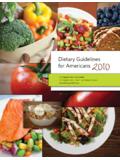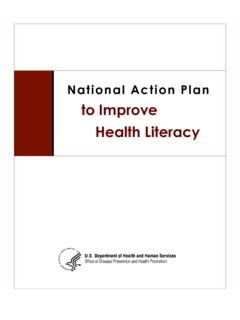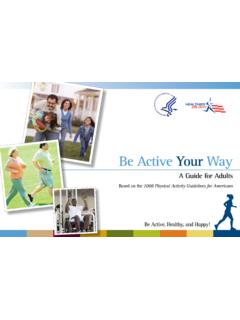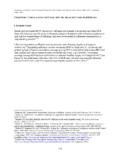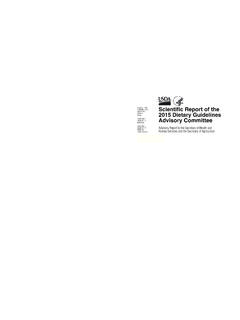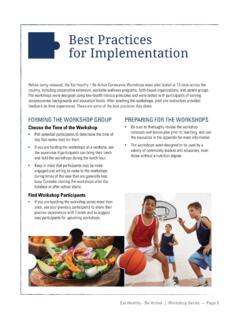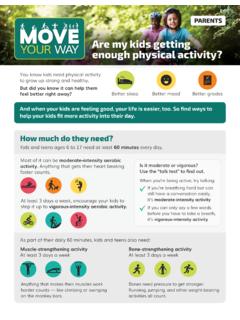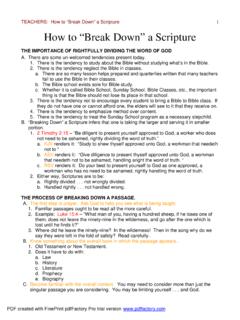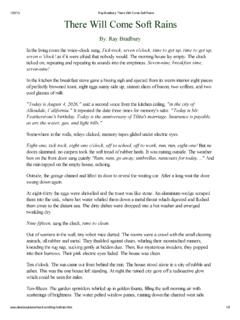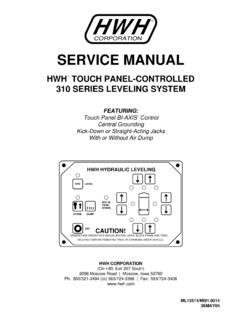Transcription of DIETARY Cut Down - Health
1 2015 2020 DIETARY Guidelines for Americans Cut down on Added Sodium Page 1 DIETARY GUIDELINES2015-2020 EIGHTH EDITIONFOR AMERICANSCut down on SodiumGet the facts about sodium and salt from the DIETARY Guidelines for Americans. Limiting sodium by eating out less and making smart choices at the grocery store can have Health benefits. What is sodium?Sodium is a mineral, and most of the sodium in our foods comes from salt. We all need a little sodium to stay healthy. Eating too much sodium can lead to high blood pressure (hypertension). High blood pressure can raise your risk of having a heart attack or stroke. The good news is that cutting down on sodium can help lower your blood pressure or keep it at a healthy level.
2 What foods are high in sodium?Whenever you add salt to your food, you re adding sodium. But the DIETARY Guidelines shows that most of the sodium we eat doesn t come from our saltshakers. Sodium is used by food manufacturers and others who prepare foods as a preservative and to add flavor, cure meat, thicken sauces, and keep some foods moist. That s why sodium is found in almost all of the processed and prepared foods we buy. Dishes with many ingredients like pizza, casseroles, burgers, tacos, and sandwiches tend to have ingredients that are high in sodium. When making these dishes, limit ingredients that are often high in sodium: Processed meats, poultry, and seafood like deli meats,sausages, pepperoni, and sardines Sauces, dressings, and condiments Instant products like flavored rice, instant noodles, andready-made pastaKeep in mind that even foods that don t taste salty may still be adding sodium to your diet, especially if you eat them often.
3 For example, the sodium found in foods like breads and tortillas, cheese, and condiments can add Recommendations: Sodium Age rangeAmount of sodiumAdults* and children 14 years and olderLess than 2,300 mg a day Children ages 9 to 13 Less than 2,200 mg a dayChildren ages 4 to 8 Less than 1,900 mg a dayChildren ages 2 to 3 Less than 1,500 mg a day*Adults without hypertension or prehypertensionAdults with hypertension or prehypertension can lower their blood pressure even more by limiting sodium intake to 1,500 mg a and salt what s the difference? Since most sodium in our foods comes from salt, people use the 2 words as if they re the same thing. They re actually a little different.
4 Sodium is a mineral that s in salt. Salt is also known as sodium can I cut down on sodium?Pay close attention to the foods you choose when you re grocery shopping and eating out. Try making these 5 small changes. the Nutrition Facts label. Before you buya food or drink, look for the amount of sodium on theNutrition Facts label. Compare different options andchoose the one with the lowest can also look out for foods that are labeled low-sodium, reduced sodium, or no-salt-added. But keepin mind that sometimes foods without these labelsare still lower in sodium so it s always a good ideato check the Nutrition Facts out which foods you eat have the most sodium. You can use the USDA s SuperTracker( ) to get an idea.
5 For dishes higher in sodium, consider eating smaller portionsor eating them less healthy shifts. Replace higher-sodium foods or ingredients with healthier options. You can:Snack on unsalted nuts instead of snacks like salted pretzelsChoose fresh skinless chicken and turkey, lean meats, and seafood instead of processed deli meats or sausagesGo for fresh, frozen vegetables without sauce, and canned vegetables with the least amount of sodiumWhen eating out, you can: Ask for the written nutrition information and look for items that are lower in sodium Get dressings and sauces on the side and add only the amount you need to your meal Ask to have no salt added to your more at home.
6 Making your own meals instead of eatingat restaurants or buying packaged foods is a great way to eat lesssodium because you re in control. To add flavor, use spices instead of saltor packaged sauces and the DIETARY Approaches to Stop Hypertension (DASH)eating plan. Based on scientific evidence, the DASH plan helps limitsodium and unhealthy fats. Think about following the DASH eating planat the lower-sodium option of 1,500 mg per day if you have hypertensionor prehypertension. Learn more about it at slices of thick-crust pizza with pepperoni add up to about 2,270 mg of sodium almost the daily recommended sodium limit for adults and children 14 years and up!There are lots of different types of salt: table salt, kosher salt, sea salt, Himalayan salt, and more.
7 To lower the sodium in your diet, you need to cut down on all types of salt, including salt already in to learn more about sodium and how to find a healthy eating pattern that works for you or your family? Check out for more information on the DIETARY Guidelines and for online tools, recipes, and more. 2015 2020 DIETARY Guidelines for Americans Cut down on Added Sodium Page 2 December 2016
